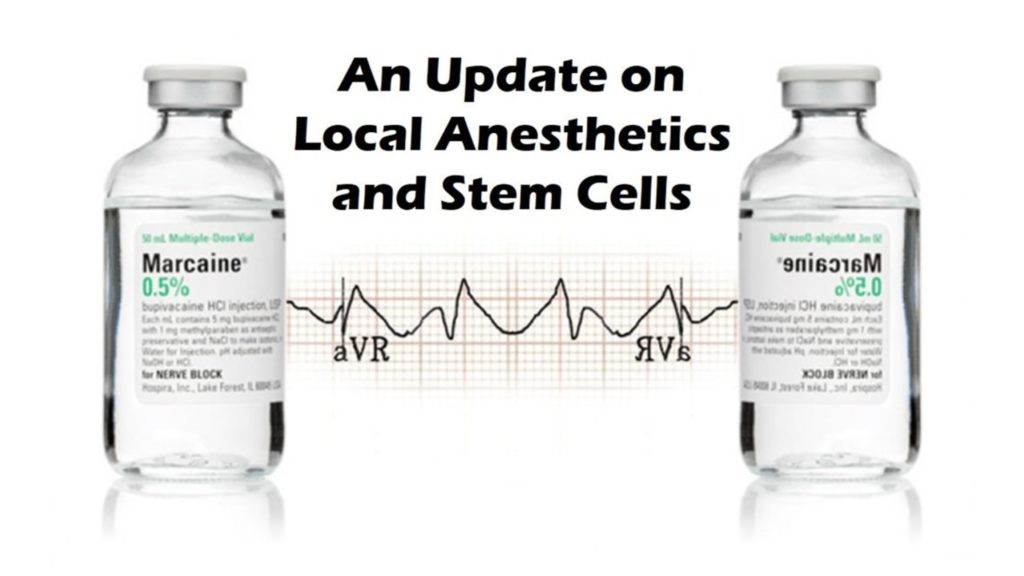Why Commonly Used Local Anesthetics Are Dangerous to Stem Cells

Doctors use local anesthetics like water in medical procedures. In fact, because they can reduce patient pain, the more the merrier. However, in a stem cell procedure, this is a bad idea as most common local anesthetics kill the cells quite dead. Hence, is your doctor injecting anesthetics that will kill the cells? Are you as a provider still using anesthetics with stem cells? Let’s dig in.
What Is a Local Anesthetic?
A local anesthetic is a medication that can be injected that numbs tissue. They’re used very commonly in injection procedures to help with skin or soft-tissue pain. There are two families which include:
Amide Type:
- Lidocaine
- Mepivacaine
- Prilocaine
- Bupivacaine
- Etidocaine
- Ropivacaine
- Levobupivacaine
Ester Type:
- Cocaine
- Procaine
- Tetracaine
- Chloroprocaine
- Benzocaine
Doctors love bupivacaine (Marcaine) because it lasts a long time (12-24 hours), but as I’ll show it’s very toxic to stem cells. The most commonly used anesthetic in the US is lidocaine, which as I’ll show also has problems.
The Research on Anesthetics and Stem Cells
Way back in 2007, before 99.99% of physicians had heard of the term stem cell let alone had used one in daily practice, we knew we had an issue. We had been using stem cells for two years in treating common orthopedic problems, but we also generally used local anesthetics. Hence we added various local anesthetics to mesenchymal stem cells in culture and what we found was startling. Bupivacaine, one of the most commonly used anesthetics in spine care back then and still today was toxic to the stem cells down to homeopathic doses. Lidocaine was a little better but still very toxic. Hence we stopped using any local anesthetics around stem cells.
By 2013, a paper was published that seemed to show that using bupivacaine was fine with stem cells (1). Huh? That didn’t fit with our research. When we looked at the details of the paper it was poorly done, so we decided to replicate it. In 2014 our paper was published showing that both bupivacaine and lidocaine caused stem cells to go into pre-programmed cell death (apoptosis) and damaged the endoplasmic reticulum in the cells, but an obscure local anesthetic called ropivacaine was safer to use in the right doses. We again made changes to our practice and got the word out at conferences and online.
What has happened since 2014? Let’s review what we know from other studies.
- A 2016 paper showed that etomidate, an anesthetic used IV didn’t impact adipose MSCs, but the study used very simple methods to measure cell health (3).
- Another 2016 paper demonstrated that bupivacaine and lidocaine both hurt the ability of MSCs to suppress inflammation (6).
- Research in 2017 again confirmed that bupivacaine was a bad actor for tendon cells, but took no issues with ropivacaine or steroid and believed that MSCs were protected from bupivacaine (4). However, they used a short duration of exposure and only measured one aspect of cell health.
- A 2019 study showed that lidocaine was very toxic to adipose MSCs and disrupted their gene expression (5).
- A 2021 investigation again showed that bupivacaine and lidocaine were toxic to MSCs (altered gene expression, proliferation, and cell surface markers) with ropivacaine being less toxic (7).
Hence, the balance of the research still shows that using bupivacaine and lidocaine are problems around MSCs.
What Is Your Doctor Using?
The big problem out there that I have blogged on many times before is that it’s the stem cell wild west out there. While these problems with the commonly used local anesthetics like bupivacaine and lidocaine have been talked about extensively at conferences and online is discussions, there’s still a huge swath of providers offering MSC-based therapies who haven’t gotten the memo. So your first question as a patient is whether your doctor is planning on using these medications during your procedure.
The upshot? Local anesthetics are a problem when used in contact with stem cells. The only one that seems to have reasonable evidence that it’s safer than the others is ropivacaine. Hence, if you’re a provider, hopefully, you’ll get the memo. If you’re a patient, make sure your doctor got the memo!
_________________________
References
(1) Rahnama R, Wang M, Dang AC, Kim HT, Kuo AC. Cytotoxicity of local anesthetics on human mesenchymal stem cells. J Bone Joint Surg Am. 2013 Jan 16;95(2):132-7. doi: 10.2106/JBJS.K.01291. PMID: 23324960.
(2) Dregalla RC, Lyons NF, Reischling PD, Centeno CJ. Amide-type local anesthetics and human mesenchymal stem cells: clinical implications for stem cell therapy. Stem Cells Transl Med. 2014 Mar;3(3):365-74. doi: 10.5966/sctm.2013-0058. Epub 2014 Jan 16. PMID: 24436443; PMCID: PMC3952925.
(3) Park H, Ryu K, Kim YH, Choi WJ, Ko D. The effects of etomidate and midazolam on adipose tissue-derived mesenchymal stem cell proliferation. Korean J Anesthesiol. 2016 Dec;69(6):614-618. doi: 10.4097/kjae.2016.69.6.614. Epub 2016 Sep 8. PMID: 27924203; PMCID: PMC5133234.
(4) Zhang AZ, Ficklscherer A, Gülecyüz MF, Paulus AC, Niethammer TR, Jansson V, Müller PE. Cell Toxicity in Fibroblasts, Tenocytes, and Human Mesenchymal Stem Cells-A Comparison of Necrosis and Apoptosis-Inducing Ability in Ropivacaine, Bupivacaine, and Triamcinolone. Arthroscopy. 2017 Apr;33(4):840-848. doi: 10.1016/j.arthro.2016.10.026. Epub 2017 Jan 12. PMID: 28089496.
(5) Nie H, Kubrova E, Wu T, Denbeigh JM, Hunt C, Dietz AB, Smith J, Qu W, van Wijnen AJ. Effect of Lidocaine on Viability and Gene Expression of Human Adipose-derived Mesenchymal Stem Cells: An in vitro Study. PM R. 2019 Nov;11(11):1218-1227. doi: 10.1002/pmrj.12141. Epub 2019 May 30. PMID: 30784215; PMCID: PMC6699924.
(6) Gray A, Marrero-Berrios I, Weinberg J, Manchikalapati D, SchianodiCola J, Schloss RS, Yarmush J. The effect of local anesthetic on pro-inflammatory macrophage modulation by mesenchymal stromal cells. Int Immunopharmacol. 2016 Apr;33:48-54. doi: 10.1016/j.intimp.2016.01.019. Epub 2016 Feb 6. PMID: 26854576; PMCID: PMC4779686.
(7) Kubrova E, Su M, Galeano-Garces C, Galvan ML, Jerez S, Dietz AB, Smith J, Qu W, van Wijnen AJ. Differences in Cytotoxicity of Lidocaine, Ropivacaine, and Bupivacaine on the Viability and Metabolic Activity of Human Adipose-Derived Mesenchymal Stem Cells. Am J Phys Med Rehabil. 2021 Jan 1;100(1):82-91. doi: 10.1097/PHM.0000000000001529. PMID: 32657816.

NOTE: This blog post provides general information to help the reader better understand regenerative medicine, musculoskeletal health, and related subjects. All content provided in this blog, website, or any linked materials, including text, graphics, images, patient profiles, outcomes, and information, are not intended and should not be considered or used as a substitute for medical advice, diagnosis, or treatment. Please always consult with a professional and certified healthcare provider to discuss if a treatment is right for you.
